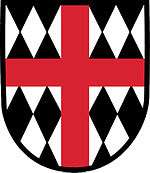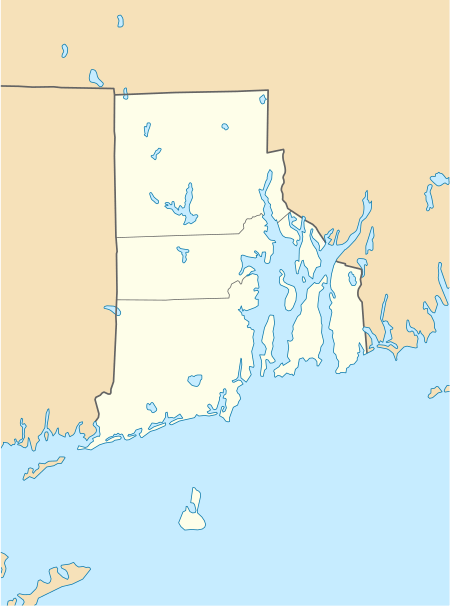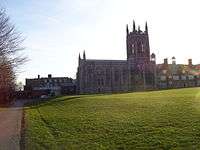St. George's School, Newport
St. George's School is a private, Episcopal, coeducational boarding school in Middletown, Rhode Island, United States, just east of the city of Newport, on a hill overlooking the Atlantic Ocean. The school was founded in 1896 by the Rev. John Byron Diman. It is a member of the Independent School League and is one of five schools collectively termed St. Grottlesex.
| St. George's School | |
|---|---|
 | |
| Address | |
372 Purgatory Rd, Middletown, RI 02842 , United States | |
| Coordinates | 41°29′28″N 71°16′24″W |
| Information | |
| Type | Private secondary, day and boarding |
| Motto | Sapientia Utriusque Vitae Lumen ("Wisdom, the light of every life.") |
| Denomination | Episcopal |
| Established | 1896 |
| Head of School | Alixe Callen |
| Grades | 9–12 |
| Gender | Coeducational |
| Enrollment | 370 |
| Campus | Suburban |
| Color(s) | Red, black, and white |
| Athletics conference | ISL |
| Mascot | Dragon |
| Rival | Middlesex School |
| Newspaper | The Red & White |
| Yearbook | The Lance |
| Website | St. George's website |
St. George's School—Church of St. George, Little Chapel, and Memorial Schoolhouse | |
  | |
| Location | 372 Purgatory Rd., Middletown, Rhode Island |
| Coordinates | 41°29′27″N 71°16′6″W |
| Area | less than one acre |
| Built | 1910 |
| Architect | Cram, Ralph Adams; et al. |
| Architectural style | Tudor Revival, Late Gothic Revival |
| NRHP reference No. | 04001235[1] |
| Added to NRHP | November 12, 2004 |
History
The school was founded in 1896 by the Rev. John Byron Diman, a member of a prominent Rhode Island family.[2]
In his "Purposes of the School", Diman wrote:
The specific objectives of St. George’s are to give its students the opportunity of developing to the fullest extent possible the particular gifts that are theirs and to encourage in them the desire to do so. Their immediate job after leaving school is to handle successfully the demands of college; later it is hoped that their lives will be ones of constructive service to the world and to God.[3]
On 1972, this school became co-educational[4].
Campus
The school's campus is familiarly known as "The Hilltop", as it is located on a prominent hill just east of Newport. Its oldest buildings are on the National Register of Historic Places.[5] The layout of the campus was designed by Frederick Law Olmsted.[6]
- Memorial Schoolhouse – The main academic building, in which most classes are held, in subjects other than art, music, and science. Designed by McKim, Meade & White[7]
- Old School – The oldest building on campus, Old School serves a variety of purposes. The first floor serves as the office of the Head of School, as well as many administrators and admissions counselors. To the east, the Main Common Room serves as a meeting space for various purposes. The Faculty Lounge and kitchen are attached to the Main Common Room. On the second and third floors are the Old School (girls) and Red (boys) dormitories.
- DuPont Science Building – Hosting all science classes, it houses laboratories for all physical sciences, and is close by the observatory. It also has a large hall used for presentations or examinations.
- Chapel – A classic Gothic chapel built in 1928, with John Nicholas Brown's donation and designed by Ralph Adams Cram. The whole school congregates in the Chapel for two services weekly, one of which is an Episcopal Church service. There are two additional optional services; a Friday night Compline service, and a Sunday Evening Prayer. In 2005, the Chapel organ was completely renovated. The Chapel now also features a choral practice space. Once a week the chapel choir, consisting of nearly 80 students, sings.
- Hill Library – Contains more than 40,000 volumes and 75 periodicals.
- John Nicholas Brown '18 Center – Named in honor of school alumnus John Nicholas Brown, class of 1918, the Brown Center was dedicated in the spring of 2005. It houses the College counseling offices on the main level; deans' offices on the second floor (director of studies, dean of students, dean of faculty); and the bookstore, Geronimo office, mail room and summer school office on the lower level.
- Sixth-Form House – Originally used as the school gymnasium in 1903, it was converted to classroom use in 1911. Dormitory rooms for school prefects were also once located in the building. Currently, the business office, advancement office, and communications office are housed in Sixth-Form House.
- King Hall – The school's dining hall, it serves three meals daily
- William H. Drury and Richard Grosvenor Center for the Arts – home to St. George's 450-seat theatre, where drama productions, musical performances, and lectures are held. The building also features a black box theatre, a scenery shop (used by Stage Crew for the drama productions), many soundproof practice rooms, an exhibition gallery, two drawing studios, a painting studio, ceramics and photography studios, and two computer labs.
- Charles A. and Carol J. Hamblet Campus Center – Named in honor of the 10th headmaster and his wife, the Campus Center was dedicated in the fall of 2004. It includes a grille restaurant open during the off-hours of King Hall, a great room, a game room, and a meeting room.
- Dorrance Field House – Built in 1987, the Field House includes four indoor tennis courts, three basketball courts, and a ninth-of-a-mile indoor track.
- Hoopes Squash Center – The Joseph C. Hoopes Sr. Squash Center, housing eight international glass-backed courts, was completed in 1996. Using the German made ASB court system, it serves during the summer months as the home for Mark Talbott's Squash Academy, the official training center of the U.S. Squash Racquets Association. It served as the site for both the National Junior Squash Championships in 1996 and 1998, and the Men's Squash Softball Championships in February 1997.
- Stephen P. Cabot and Archer Harman Ice Center – The $4.5 million Stephen P. Cabot and Archer Harman Jr. Ice Center, completed in November 2000, features two ice hockey facilities. Originally built in 1954 as an outdoor rink and enclosed in 1968, the Cabot Memorial rink has new boards, a completely new surface (200′ × 85′) and a new roof.
- Norris D. Hoyt Pool – The Norris D. Hoyt Swimming Pool is an eight-lane pool with overflow gutters and a Colorado Timing System. Completed in the fall of 2004, the pool holds a large balcony seating area as well as many deck-level glass viewing windows.
- Ted Hersey Track – The track is all-weather, completed in the fall of 1996. It is a six-lane, 400-meter oval, with an eight-lane sprint chute along the east side. All St. George's field events are held on the inside, with the exception of the javelin throw. It includes the high jump area at the northern end of the oval, the discus throw area at the northwestern corner, the shot put area at the northeastern corner, the long and triple jump parallel along the western straight-away, and the pole vault way parallel to the eastern straightaway. The area inside the oval is Redway Field and is large enough for an international-sized soccer field (360 feet by 225 feet). The track is named for the longest-serving (1952–2004) faculty member in school history, who founded the programs in cross-country and track-and-field.
- Blazer and Wood Tennis courts – Blazer Tennis Courts are hardcourt-surfaced courts located at the main entrance of the school. Both junior varsity teams host their games on these courts. The Wood Tennis Courts are six hardcourt-surfaced courts located across the street from the main entrance of the school.
- Playing Fields – The 10 athletic fields include Crocker Field (used for varsity football and girls' varsity lacrosse), Elliott Field (used for varsity baseball), a JV baseball field, two field hockey fields, four lacrosse/soccer fields, and a softball field.
- There are five boys' dorms and six girls' dorms. Two or three faculty members live with their families in apartments within each of the buildings.
 The exterior of the St. George's School Chapel
The exterior of the St. George's School Chapel The "Hilltop", viewed from Second Beach
The "Hilltop", viewed from Second Beach
Academics

As of the 2016–17 school year, students are required to take a minimum of four years of English, mathematics through precalculus, three years of a foreign language, two years of laboratory science courses, two years of social sciences, three trimesters of religious studies, and three trimesters of art classes.[8]
- Tuition and fees
Cost of attendance (2016–2017)[9]
- Boarding student: $58,000
- Day student: $39,900
Extracurricular activities
The school is a member of the Independent School League (ISL) and the New England Preparatory School Athletic Council (NEPSAC).[10][11]
- Sailing school vessel

Geronimo is a Ted Hood-designed 69-foot fiberglass sloop. Three times during the academic year, Geronimo carries students from St. George's School on six-week-long voyages. The ship sails year-round between Canadian waters and the Caribbean and is now making a two-year-long journey to the Mediterranean. Students are taught nautical science and oceanography/marine biology while on board. Summer trainees range in age from high school to adult.[12][13]
In popular culture
- St. George's is mentioned in F. Scott Fitzgerald's classic first novel, This Side of Paradise, where the school is described as "prosperous and well-dressed".
- The school is featured in The Official Preppy Handbook by Lisa Birnbach.
- The Education of Charlie Banks (2007), co-starring Jesse Eisenberg and Eva Amurri and directed by Fred Durst, was filmed on the campus of St. George's. The establishing shots of the Old School building, King Hall, and the chapel were used to represent Vassar College. The motion picture also filmed at Brown University in Providence, R.I.
Notable alumni


- Vincent Astor, philanthropist, majority owner of Newsweek, member of the prominent Astor family
- John Jacob Astor V, philanthropist, owner of The Times
- John Jacob Astor VI, investor, of the Astor family
- Leonard Bacon, class of 1905, well recognized poet, writer, book critic, and winner of the Pulitzer Prize for poetry in 1940
- Livingston L. Biddle, Jr., 1936, a descendant of the Philadelphia family, who wrote the legislation that led to the creation of the National Council on the Arts and the National Endowment for the Arts, of which he was chairman from 1977 to 1981. From 1968 to 1970, he was a professor, and the chairman of the arts division, at Fordham University, in New York City; and in 1971 and 1972 he was chairman of the Pennsylvania Ballet Company.
- Julie Bowen, 1987, actress best known for playing Claire Dunphy on Modern Family
- John Nicholas Brown, 1918, philanthropist, donor of the school's Chapel, member of the Brown family of Rhode Island, and former Assistant Secretary of the Navy
- Billy Bush, 1990, Access Hollywood anchor and host of the NBC prime-time show Let's Make a Deal
- Prescott Bush, 1913, World War I artillery captain, U.S. Senator from Connecticut 1953–1963, father of President George H. W. Bush, and grandfather of President George W. Bush
- Tucker Carlson, 1987, writer and former host of Crossfire on CNN, followed by Tucker on MSNBC, and now the host of Tucker Carlson Tonight on Fox News
- Peter Cook (American anchor), 1985, Washington anchor for Bloomberg Television
- Philippe Cousteau Jr., 1998, founder of EarthEcho International, grandson of Jacques-Yves Cousteau
- Charles Dean, 1968, brother of Howard Dean, captured and executed in Laos
- Howard Brush Dean III MD, 1966, longest-serving Vermont governor 1991–2003, presidential candidate in 2004, and Chairman of the Democratic National Committee 2005–2009
- David Gilbert, 1986, author
- Robert E. Gross, 1915, American aviation businessman, founder and president of the Lockheed Corporation from 1934 to 1956. Featured in the 2004 blockbuster hit The Aviator
- William C. Hayes, 1961, leading authority on Egyptian history, and former curator of Egyptian art at the Metropolitan Museum of Art
- Frederic Rhinelander King, 1904, architect of the Episcopal Church of the Epiphany, York Avenue and 74th Street in New York City, and the Women's National Republican Club
- Laurence G. Leavitt, headmaster of Vermont Academy, Saxtons River, Vermont, for 25 years
- Anthony Mason, 1974, longstanding senior correspondent for CBS News and co-anchor of CBS This Morning
- Ogden Nash, 1920, American poet and writer
- Diane Nelson, 1985, president of DC Entertainment from 2009 to 2018, and president and chief content officer of Warner Bros. Interactive Entertainment from 2013 to 2018
- Richard Painter, 1980, Professor of Corporate Law at the University of Minnesota Twin Cities, chief White House ethics lawyer in the George W. Bush administration
- Morgan Parker, inventor of the disposable scalpel
- Claiborne Pell, 1936, longest-serving Rhode Island Senator (in office 1961–1997); creator of the Pell Grant
- Roger W. Straus, Jr., co-founder of Farrar, Straus and Giroux, a New York book publishing company
- Ian W. Toll, 1985, American author and historian
- Whitney Tower, longtime horse-racing journalist, and former chairman of the National Museum of Racing and Hall of Fame
- Russell E. Train, 1937, founder and past-president of the World Wildlife Fund
- William Henry Vanderbilt III, Governor of Rhode Island, philanthropist
- Harry Werksman, writer-producer for the third season of Grey's Anatomy
- Wilfrid Zogbaum, US avant-garde sculptor
Sexual abuse reports
In early 2016 the school stated that sexual abuse of students had occurred, dating from the 1970s, and perpetrated by employees and students. St. George's "repeatedly failed to notify police and child welfare authorities as required by law", a news report said. Many accusers at the time contested school assertions that accusations were only recent and "much of their anger has fallen on [the head of school]", the report continued.[14] The extensive abuse—"at least 51 students were abused by employees ... and at least 10 others by fellow students"—was further documented in a 400-page independent report released in September.[15][16][17][4]
The independent report also noted the following positive observation. "Fortunately, St. George’s is certainly a very different place now. We find that St. George’s current leaders have established a culture of respect for the students who attend there now, including new traditions that set an entirely different tone for students and faculty than prevailed during the 1970s and 1980s. We also find that St. George’s has in place programming, policies, practices, and systems intended to eliminate, to the largest extent possible, faculty abuse of students and student-on-student abuse, and to address correctly reports of abuse or assault should they arise. And the school is committed to a process of continuous improvement to ensure that its practices remain those thought best to address difficult issues of faculty and student boundaries, student sexuality, and new opportunities for harm that digital and other new technologies may bring." [16]
References
- "National Register Information System". National Register of Historic Places. National Park Service. July 9, 2010.
- "Quick Facts". St. George's School. Retrieved March 16, 2016.
- "Mission & Leadership". St. George's School. Retrieved October 23, 2018.
- Wallace, Benjamin. "How St. George's Atonement for Its Sex-Abuse Scandals Turned Ugly". Vanity Fair. Retrieved 2020-05-20.
- "National Register of Historic Places 2004 Weekly Lists (PDF): 11/08/04 THROUGH 11/13/04" (PDF). National Park Service. Retrieved 2 February 2020.
- http://memory.loc.gov/service/mss/eadxmlmss/eadpdfmss/uploaded_pdf/ead_pdf_batch_28_december_2005/ms001018.pdf Box B30
- http://dlib.nyu.edu/findingaids/html/nyhs/mckim/dscref12.html Folder FF21
- "Diploma Requirements" (PDF). www.stgeorges.edu. St. Georges School. Retrieved 21 February 2019.
- "Tuition & Financial Aid". St. George's School. Retrieved March 19, 2016.
- "Independent School League". isleague.org. Independent School League. Retrieved 24 January 2015.
- "Member Schools – NEPSAC". www.nepsac.org. New England Preparatory School Athletic Council. Retrieved 24 January 2015.
- "St. Georges School: Geronimo". St. George's School. Retrieved 24 January 2015.
- "Vessel Details – Geronimo". Sailing Ship Adventures. Retrieved 24 January 2015.
- "Sex abuse scandal rocks exclusive New England prep school" (Archive). Associated Press at CBS News. January 21, 2016. Retrieved on January 21, 2016.
- Perez-Pena, Richard, "‘Private Hell’: Prep School Sex Abuse Inquiry Paints Grim Picture", New York Times, September 1, 2016. Retrieved 2016-09-01.
- Murphy, Martin F., "Sexual Abuse at St. George’s School and the School’s Response: 1970 to 2015 (Report of Independent Investigator)", Foley Hoag LLC, September 1, 2016. Retrieved 2016-09-01.
- Redden, Molly (2016-09-01). "One in five girls at St George's school in 1970s sexually abused by trainer: report". The Guardian. ISSN 0261-3077. Retrieved 2020-05-20.
Further reading
- Alumni Association of Saint George's School (1920). Saint George's School in the War. Boston: The Merrymount Press.
External links
| Wikimedia Commons has media related to Saint George's (Middletown, Rhode Island). |